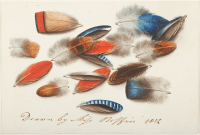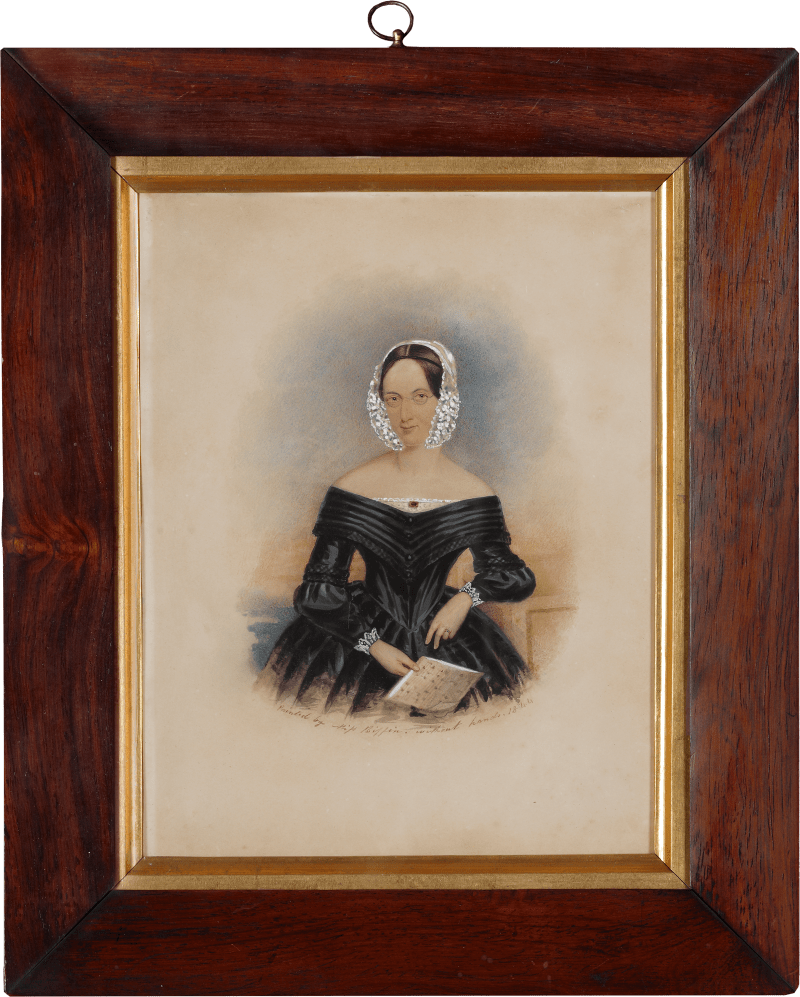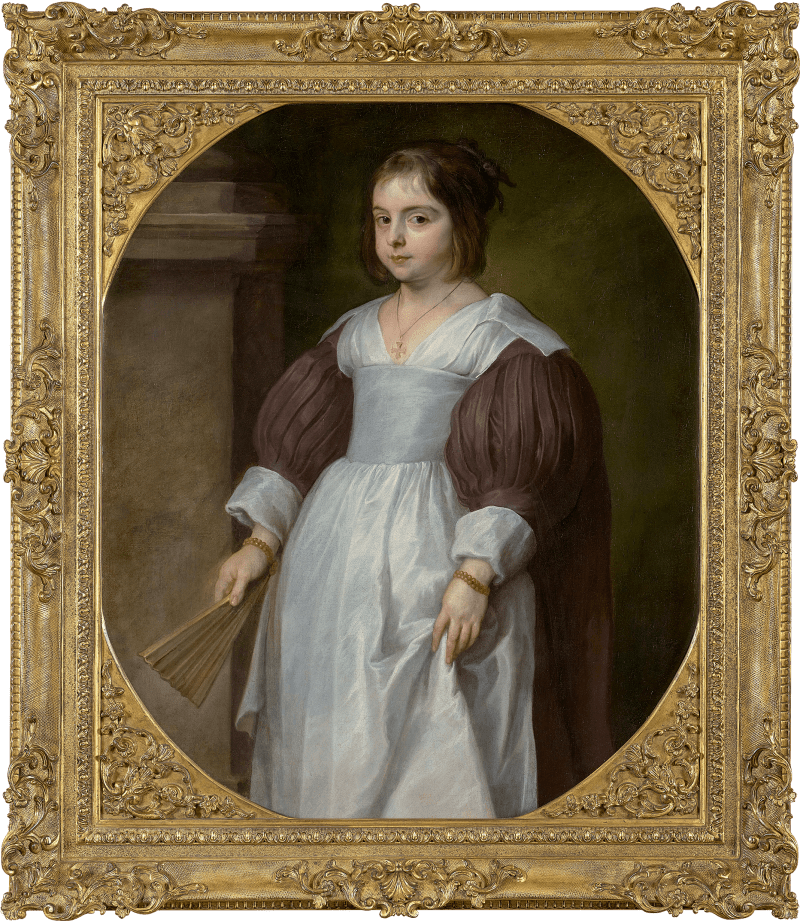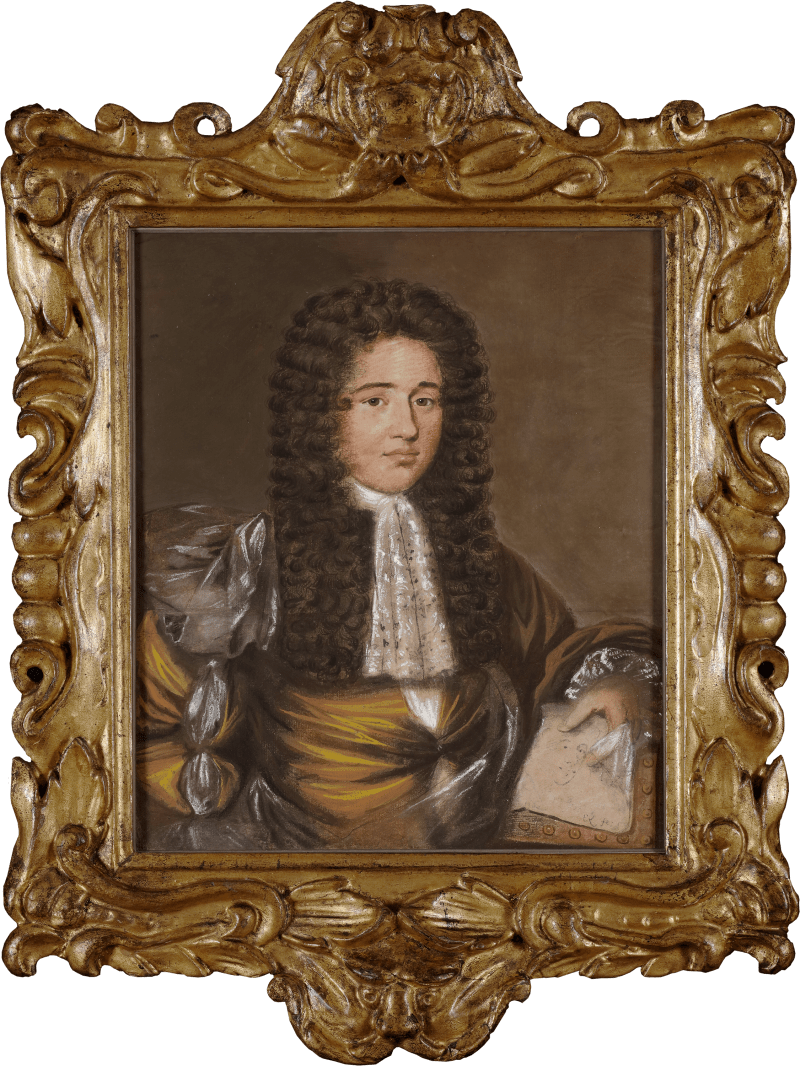This delicate depiction of feathers was painted by Sarah Biffin, one of the most accomplished and entrepreneurial British artists at work during the nineteenth century. This watercolour, which remains in an immaculate state of preservation, exemplifies Biffin’s remarkable technical understanding of watercolour as a medium.
Biffin was born into a farming family in Somerset in 1784, and her baptism records show that she was ‘born without arms and legs’. Teaching herself to write and draw from a young age, she began her career in 1804 at twenty years old when a man named Mr Dukes offered her employment as part of a travelling act: ‘it was suggested to my Parents that a comfortable living might be obtained by Public Exhibition, and an engagement was arranged for that purpose.’[1] Biffin left her family home to travel across the country with Dukes; she signed a contract with her new employer and began a tirelessly itinerant lifestyle, exhibiting at fairs and in regional...
This delicate depiction of feathers was painted by Sarah Biffin, one of the most accomplished and entrepreneurial British artists at work during the nineteenth century. This watercolour, which remains in an immaculate state of preservation, exemplifies Biffin’s remarkable technical understanding of watercolour as a medium.
Biffin was born into a farming family in Somerset in 1784, and her baptism records show that she was ‘born without arms and legs’. Teaching herself to write and draw from a young age, she began her career in 1804 at twenty years old when a man named Mr Dukes offered her employment as part of a travelling act: ‘it was suggested to my Parents that a comfortable living might be obtained by Public Exhibition, and an engagement was arranged for that purpose.’[1] Biffin left her family home to travel across the country with Dukes; she signed a contract with her new employer and began a tirelessly itinerant lifestyle, exhibiting at fairs and in regional towns and cities across the length and breadth of Britain, where she would sew, write and paint in front of paying crowds.
Meticulously rendered studies of feathers constitute a substantial, if fleeting, trope within Biffin’s early oeuvre. All her known feather studies were painted between 1811 and 1812 when she was travelling under the employment of Dukes. She likely adopted feathers as a subject for their visual complexities as well as their availability – feathers were readily used as decorative adornments to ladies’ hats and accessories throughout the nineteenth century.
The excellent condition of the present watercolour offers an unquestionable indication of Biffin’s remarkable artistic aptitude as a young artist. The verisimilitude of the colourfully barred stripes, mottled patterns, and soft, downy barbs at the base of every plume amount to trompe l'oeil, creating the impression the feathers might spontaneously float off the paper. This level of technical competence and handling of watercolour was a remarkable achievement for a young artist at the beginning of her training and demonstrates her early propensity for detailed observation.
Biography
Sarah Biffin was born in 1784 to Henry and Sarah Biffin (née Perkins), a farming family in East Quantoxhead, Somerset, England. At six days old she was baptised with her mother’s Christian name and her baptism record plainly states: ‘Daughter of Henry and Sarah Biffin was baptised on the 31st October, born without arms or legs.’[2]
From the age of eight, Biffin learned to thread a needle and sew using her mouth and shoulder, and at twelve years old she had taught herself to write. Aspiring to further artistic acquirements, in 1804 Biffin met a man named Mr Dukes who reportedly taught her the first rudiments of painting.
‘… it was suggested to my Parents that a comfortable living might be obtained by Public Exhibition, and an engagement was arranged for that purpose …’[3]
At twenty years old, Biffin left her family home to travel across the country with Dukes. She signed a contract with her new employer and began exhibiting at fairs in regional towns and cities. Biffin would sew, write and paint in front of audiences, who were charged an admission fee and left with a sample of her writing. Biffin travelled extensively and her touring schedule unfolded over a course of around fifteen years, between 1804 and 1819. [4] She pursued a tirelessly itinerant lifestyle and travelled to every corner of Great Britain, publicly advertising her arrival in every town and city she visited.
In 1808, she met George Douglas, 16th Earl of Morton, Chamberlain to the Queen’s Household. Morton greatly admired Biffin’s artistic skill and presented her work before King George III. Morton assisted Biffin in shaping her career as a portrait miniaturist, and she was soon taking portrait commissions across the country.
‘…I have turned my thoughts to the pursuit of miniature painting in London…’[5]
In 1821, Biffin acquired a studio in London and submitted work to the annual exhibition at the Royal Academy of Arts. In May of 1821, she received a silver medal from The Royal Society of Arts. The award was announced by Prince Augustus Frederick, the Duke of Sussex who proclaimed that her work deserved the greatest honour and urged all attendees to patronise her.[6] Later that year she travelled abroad to Brussels where she became the miniature painter to Willem Frederik, Prince of Orange and future king of the Netherlands.
Following the extraordinary success of 1821, little can be deduced of Biffin’s life until 6 September 1824 when she married William Stephen Wright. Although she took his name and began exhibiting as ‘Mrs Wright’, the couple never lived together, and rumours were spread that he appropriated her life savings before leaving her.
Ever determined and entrepreneurial, Biffin continued with her professional practice and pursued teaching in lithography and painting on ivory.[7] She lived and taught in Birmingham where she shared a residence with an assistant, Miss Mary Ann Saunders, and fellow artist Mr R. Hill.[8] In 1830 Biffin moved to the fashionable tourist city of Brighton. In February 1830 King George IV bought a self-portrait from Biffin for twenty-five guineas, the highest sum Biffin had yet received for her work. [9] Biffin continued to strengthen her association with the Royal Family and in late 1830, she became miniature painter to Princess Augusta Sophia (the second daughter of King George III). Flaunting her new patronage - ‘Miniature Painter to H. R. H. Princess Augusta’ - atop her advertisements, Biffin continued to garner portrait commissions.
However, Biffin’s artistic ambitions continued to press upon her. In 1841, she wrote to an unknown correspondent, asking for advice on travelling to America:
‘…I am induced to take the advice of some of my Friends and apply to you for your opinion respecting an intended project which I have for some time had in mind. This project is to Visit America…’[10]
That same year, ‘Mrs Wright’ re-established her maiden name – Biffin – and arrived in Liverpool, which was the primary port for embarkation to America. She established a studio on Bold Street in which she hung her works and opened to members of the public who were willing to pay an entrance fee. However, Biffin never set sail for America and she remained in Liverpool until her death at the age of sixty-five in 1850.
However, Biffin’s move to Liverpool coincided with an onset of ill health and the decline in popularity of the portrait miniature. Fortunately, she was befriended by members of the Rathbone family, well-known Liverpool philanthropists, and by Joseph Mayer, an established arts and antiquities collector. On account of her failing eyesight and dwindling commissions, an attempt to raise money for her through a subscription was organised by Richard Rathbone, a commission merchant, and committed slavery abolitionist.[11] Biffin died in 1850 and a tombstone was erected by the Rathbone family with the poignant epitaph:
Gifted with singular talents as an Artist,
thousands have been gratified with the able
productions of her pencil, while her versatile
Conversation and agreeable manners
Elicited the admiration of all.[12]
[1] Sarah Biffin, ‘An Interesting Narrative and proposals for a print of Miss Beffin to be dedicated, by permission to HRH the Princess Augusta’, p.1, 942 BIF/10, Liverpool Record Office, Liverpool.
[2] Somerset, England, Church of England Baptisms, Marriages, and Burials, 1531-1812, Somerset Heritage Service; Taunton, Somerset, England; Somerset Parish Records, 1538-1914, D\P\qua.e/2/1/3.
[3] Sarah Biffin, ‘An Interesting Narrative and proposals for a print of Miss Beffin to be dedicated, by permission to HRH the Princess Augusta’, p.1, 942 BIF/10, Liverpool Record Office, Liverpool.
[4] Biffin’s first exhibition of 1804 is datable due to an 1805 advertisement which states that Biffin was ‘never exhibited before last March’: ‘To the Curious’, Aris's Birmingham Gazette, 6 May, 1805, p.3.
[5] Biffin, ‘Interesting Narrative’, p.2.
[6] His Royal Highness the Duke of Sussex (President of the Society of Arts), 1821, extract from his speech in the presentation of the Large Silver Medal to Sarah Biffin 1821.
[7] ‘Just Returned from the Continent’, Birmingham Chronicle, 10 November 1825, p.1; ‘Mrs Wright, Miniature Painter, Born Without Arms.’, Birmingham Chronicle, 17 November 1825, p.1.
[8] ‘R. Hill’, Birmingham Journal, 13 January 1827, p.1.
[9] Mr Parker (on behalf of Mrs Wright), letter to Sir William Knighton, 20 February 1830. George IV bills, GEO/MAIN/26577-26593, Royal Collections Trust.
[10] Sarah Biffin, letter to anonymous recipient, 1 September 1841. Harvard College Library; a copy of this letter is held in 942 BIF/10, Liverpool Record Office, Liverpool.
[11] The 1847 appeal consisted of an overview of Biffin’s multitude of achievements, relationships and a request to raise a total of one-thousand pounds to guarantee Biffin an income of one-hundred pounds a year. A subscription list was also circulated, headed by the Queen Dowager, followed by The Duchess of Kent, The Duchess of Gloucester and the Duke of Cambridge: Richard Rathbone, ‘ ‘Miss Biffin, Contributions to the Fund for the purchase of an ANNUITY for MISS SARAH BIFFIN’, 942 BIF/10, Liverpool Record Office, Liverpool.
[12] Biffin’s tombstone is no longer erect. Records of its inscription have been distributed in various reproductions, including the following: William Andrews, Curious epitaphs.: Collected from the graveyards of Great Britain and Ireland, with biographical, genealogical and historical notes (London: Hamilton Adams and Company, 1883), p.124-125; ‘Notes & Queries’, Somerset Herald, 16 August 1919; ‘Sarah Biffin’s Epitaph’, Daily Post & Mercury, 20 February 1925.











